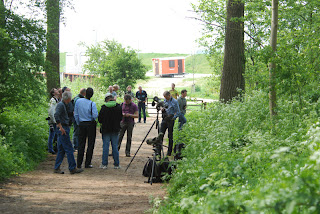Returned home yesterday after four fantastic days up north in Drenthe, in Norg. Every Hemelvaart we have a family weekend, which is always really nice. The past few years the family weekend has been held in Norg, but we've also been to other nice places in the Netherlands, such as Beerta in Groningen, or Ootmarsum in Overijssel. In between the family time my dad and I always try to squeeze in some quality birding hours, since the northern part of the Netherlands is one of the best birding places for sure!
We arrived in Norg on Wednesday evening. A Wilson's Phalarope had been around in the Ezumakeeg in the Lauwersmeer for three days already so my dad and I decided to give it a try early Thursday morning. We left at 6.00 and arrived at the Ezumakeeg just before 7.00. There were already birders present so it was a quick tick. This
female Wilson's Phalarope was such, such, a pretty bird! Never thought I would see one of these in this kind of plumage here. Really cool. The light was crappy though (looking to the east, straight into the rising sun), but through our telescope we had perfect views of the bird, foraging with
Ruffs not too far away from us. Other birds included a
Cuckoo, some
Temminck's Stints, Curlew Sandpipers,
Spotted Redshanks and a pair of
Arctic Terns.
Common Cuckoo (Cuculus canorus), male
Some recordshots (made by Tammo Meijer) of the Wilson's Phalarope (Phalaropus tricolor)
We were back early, to join the familiy, but the family was still a bit asleep. We did some hiking in the late morning/early afternoon. I didn't see too much, just some regular stuff. In the evening we drove to the Breebaartpolder, near Termunten, the outermost north eastern edge of the Netherlands probably. We were there for the reported Terek Sandpiper. The bird wasn't present however.. Nor were the reported Broad-billed Sandpipers or Greater-sand Plover that has been present for a week.
The morning of Friday, the 18th of May, my dad, my mom and I went to the Fochteloërveen, close to Norg. We did our usual walk there, seeing quite a few pairs of Whinchats, the Fochteloërveen is one of the very few sites in the Netherlands where we have breeding Whinchats. Also, we discovered a beautiful male Red-backed Shrike, a nice surprise. And above that we had calling Cranes. Probably from the couple of pairs that are breeding closeby.
Red-backed Shrike (Lanius collurio)
Whinchat (Saxicola rubetra), male
Later in the evening, I saw a nice male Bullfinch foraging on the ground, from inside our house.
Saturday we had a calm day, concerning birds, so there is nothing of interest to tell about.
Sunday would be our last day in Norg so made dad and I did some birding in the Lauwersmeer again in the morning. We started at the Jaap Deensgat, on the eastern side of the Lauwersmeer. The birding started with a singing Turtle Dove and a singing Bittern. A good start. Next to that, good numbers of Bearded Tits were showing well in the reeds. Also I met a male Bluethroat, that was singing from up close. I photographed it from every possible position, so I'm quite pleased with the result!
Bearded Tit (Panurus biarmicus), male
White-spotted Bluethroat (Luscinia svecica cyanecula), male
The rest of the morning brought 3 Montagu's Harriers, hunting above the fields. I was happy to see some Montagu's Harriers, since I've only seen a handful in the Netherlands. Near Anjum we observed a migrating Merlin. Other than that we didn't see anything rare, just some waders in the Ezumakeeg, like Little Stints, Temminck's Stints, Curlew Sandpipers etc. but no sign of the Phalarope anymore.
The pair of Montagu's Harriers (Circus pygargus), male above and female below.
After we returned to Norg we packed our bags and started our journey back. We made a little detour so we could stop by at Borger, where a Pallid Harrier had been reported. The bird was very mobile, I discovered the Pallid Harrier attacked by a Marsh Harrier from a distance. We drove to the place but the bird had gone. Later we found out the bird had flown by from close at the place where we were just standing. Luckily we still saw it hunting above the fields through the telescope, be it from a large distance. We didn't stay too long since the ladies were waiting for us! A good end of the day!

















































